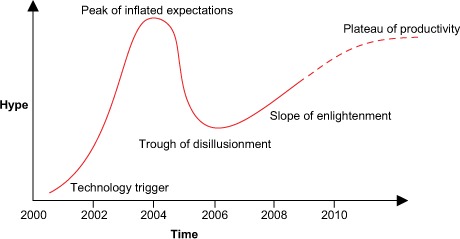A Real-World Perspective of AOP
What is the real deal with AOP? Is it something that you should embrace or ignore? What do you gain with AOP, and what do you risk by adopting it? Let’s address these important questions from a practitioner’s point of view. We’ll start with AOP in the context of the typical hype cycle. This will give us a historical perspective on AOP evolution and indicate what lies ahead. We also look at the landscape, focusing on the current situation and changes since the first edition of this book. While AOP is a more general concept, because our focus is the real world use of it, we’ll focus on AspectJ—its most prominent implementation.
Every technology goes through a cycle that’s well illustrated by the Gartner Hype Cycle (http://en.wikipedia.org/wiki/Hype_cycle). AOP is no exception. Understanding the hype cycle and the position of the technology you’re considering adopting is important. It allows you to offer a more accurate gauge of the benefits the technology is likely to offer and the risk you expose yourself to. In this section, I’ll give my assessment of the hype cycle of AOP in five major phases: technology trigger, peak of inflated expectations, trough of disillusionment, slope of enlightenment, and plateau of productivity. The following figure depicts the hype cycle and how AOP maps to it.

Hype cycle for AOP. After passing through various stages, currently AOP is on the slope of enlightenment. (Hype not to scale!)